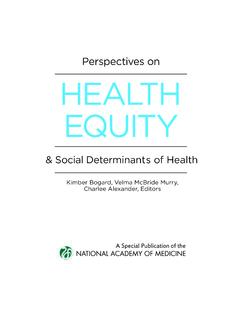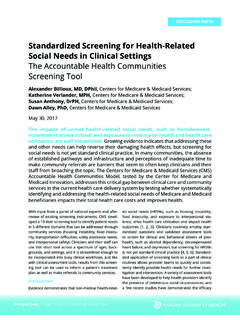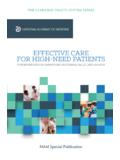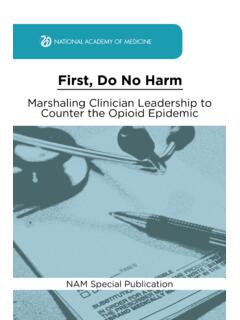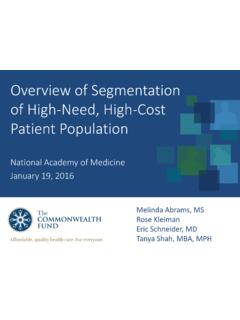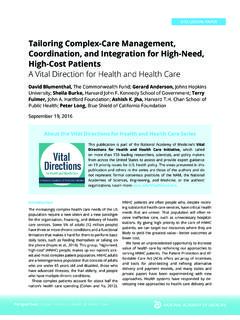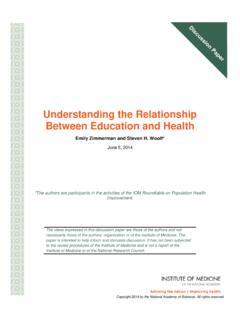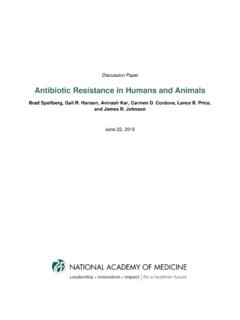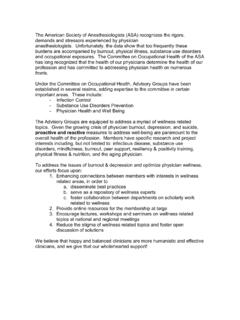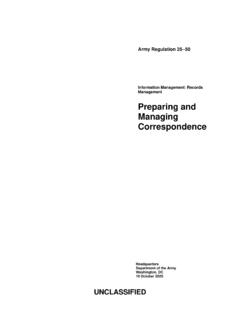Transcription of Artificial Intelligence in Health Care - National Academy of …
1 Artificial Intelligence in Health Care:The Hope, the Hype, the Promise, the PerilMichael Matheny, Sonoo Thadaney Israni, Mahnoor Ahmed, and Danielle Whicher, EditorsWASHINGTON, COPY - Uncorrected ProofsNATIONAL Academy OF MEDICINE 500 Fifth Street, NW WASHINGTON, DC 20001 NOTICE: This publication has undergone peer review according to procedures established by the National Academy of Medicine (NAM). Publication by the NAM signifies that it is the product of a carefully considered process and is a contribution worthy of public attention, but does not constitute endorsement of conclusions and recommendations by the NAM. The views presented in this publication are those of individual contributors and do not represent formal consensus positions of the authors organizations; the NAM; or the National Academies of Sciences, Engineering, and Medicine.
2 Library of Congress Cataloging-in-Publication Data to ComeCopyright 2019 by the National Academy of Sciences. All rights reserved. Printed in the United States of America. Suggested citation: Matheny, M., S. Thadaney Israni, M. Ahmed, and D. Whicher, Editors. 2019. Artificial Intelligence in Health Care: The Hope, the Hype, the Promise, the Peril. NAM Special Publication. Washington, DC: National Academy of Medicine. PREPUBLICATION COPY - Uncorrected Proofs Knowing is not enough; we must is not enough; we must do. --GOETHEPREPUBLICATION COPY - Uncorrected ProofsABOUT THE National Academy OF MEDICINEThe National Academy of Medicine is one of three Academies constituting the Nation-al Academies of Sciences, Engineering, and Medicine (the National Academies). The Na-tional Academies provide independent, objective analysis and advice to the nation and conduct other activities to solve complex problems and inform public policy decisions.
3 The National Academies also encourage education and research, recognize outstanding contributions to knowledge, and increase public understanding in matters of science, engineering, and National Academy of Sciences was established in 1863 by an Act of Congress, signed by President Lincoln, as a private, nongovernmental institution to advise the na-tion on issues related to science and technology. Members are elected by their peers for outstanding contributions to research. Dr. Marcia McNutt is National Academy of Engineering was established in 1964 under the charter of the National Academy of Sciences to bring the practices of engineering to advising the nation. Members are elected by their peers for extraordinary contributions to engineer-ing. Dr. John L. Anderson is National Academy of Medicine (formerly the Institute of Medicine) was estab-lished in 1970 under the charter of the National Academy of Sciences to advise the na-tion on issues of Health , Health care, and biomedical science and technology.
4 Members are elected by their peers for distinguished contributions to medicine and Health . Dr. Victor J. Dzau is more about the National Academy of Medicine at PREPUBLICATION COPY - Uncorrected ProofsAUTHORSMICHAEL MATHENY (Co-Chair), Vanderbilt University Medical Center and the Department of Veterans AffairsSONOO THADANEY ISRANI (Co-Chair), Stanford UniversityANDREW AUERBACH, University of California, San FranciscoANDREW BEAM, Harvard UniversityPAUL BLEICHER, OptumLabsWENDY CHAPMAN, University of MelbourneJONATHAN CHEN, Stanford UniversityGUILHERME DEL FIOL, University of Utah HOSSEIN ESTIRI, Harvard Medical SchoolJAMES FACKLER, Johns Hopkins School of MedicineSTEPHAN FIHN, University of WashingtonANNA GOLDENBERG, University of TorontoSETH HAIN, EpicJAIMEE HEFFNER, Fred Hutchinson Cancer Research CenterEDMUND JACKSON, Hospital Corporation of AmericaJEFFREY KLANN, Harvard Medical School and Massachusetts General Hospital RITA KUKAFKA, Columbia University HONGFANG LIU, Mayo ClinicDOUGLAS MCNAIR, Bill & Melinda Gates Foundation ENEIDA MENDON A, Regenstrief InstituteJONI PIERCE, University of UtahW.
5 NICHOLSON PRICE II, University of MichiganJOACHIM ROSKI, Booz Allen HamiltonSUCHI SARIA, Johns Hopkins UniversityNIGAM SHAH, Stanford UniversityRANAK TRIVEDI, Stanford UniversityJENNA WIENS, University of MichiganPREPUBLICATION COPY - Uncorrected ProofsixNAM StaffDevelopment of this publication was facilitated by contributions of the followingNAM staff, under the guidance of J. Michael McGinnis, Leonard D. Schaeffer Executive Officer and Executive Director of the Leadership Consortium for a Value & Science-Driven Health System: DANIELLE WHICHER, Senior Program Officer (until September 2019) MAHNOOR AHMED, Associate Program Officer JESSICA BROWN, Executive Assistant to the Executive Officer (until September 2019) FASIKA GEBRU, Senior Program Assistant JENNA OGILVIE, Deputy Director of CommunicationsPREPUBLICATION COPY - Uncorrected ProofsxREVIEWERSThis special publication was reviewed in draft form by individuals chosen for their diverse perspectives and technical expertise, in accordance with review procedures established by the National Academy of Medicine.
6 We wish to thank the following individuals for their contributions:SANJAY BASU, Harvard Medical SchoolPAT BAIRD, PhilipsSARA BURROUS, Washington University, St. LouisKEVIN JOHNSON, Vanderbilt University Medical CenterSALLY OKUN, PatientsLikeMeJ. MARC OVERHAGE, Cerner CorporationJACK RESNECK, JR., American Medical AssociationSARA ROSENBAUM, George Washington UniversityPAUL TANG, IBM Watson HealthTIMOTHY M. PERSONS, Chief Scientist and Managing Director, Science, Technology Assessment, and Analytics, United States Government Accountability Office (NOTE: Dr. Persons only provided editorial comments and technical advice on the description of the Artificial Intelligence technology described in the publication. Dr. Persons did not comment on any policy related recommendations and did not review or comment on any of the legal content in the publication.)
7 The reviewers listed above provided many constructive comments and suggestions, but they were not asked to endorse the content of the publication, and did not see the final draft before it was published. Review of this publication was overseen by Danielle Whicher, Senior Program Officer, NAM; Mahnoor Ahmed, Associate Program Officer, and J. Michael McGinnis, Leonard D. Schaeffer Executive Officer, NAM. Responsibility for the final content of this publication rests with the editors and the COPY - Uncorrected ProofsxiiiFOREWORDIn 2006, the National Academy of Medicine established the Roundtable on Evidence-Based Medicine for the purpose of providing a trusted venue for National leaders in Health and Health care to work co-operatively toward their common commitment to effective, innovative care that consistently generates value for patients and society.
8 The goal of advancing a Learning Health System quickly emerged and was defined as a system in which science, informatics, incentives, and culture are aligned for continu-ous improvement and innovation, with best practices seamlessly embedded in the delivery process and new knowledge captured as an integral by-product of the delivery experience advance this goal, and in recognition of the increasingly essential role that digital Health innova-tions in data and analytics contribute to achieving this goal, the Digital Health Learning Collaborative was established. Over the life of the collaborative, the extraordinary preventive and clinical medical care implications of rapid innovations in Artificial Intelligence (AI) and machine learning emerged as essential considerations for the consortium.
9 The publication you are now reading responds to the need for physicians, nurses and other clinicians, data scientists, Health care administrators, public Health offi-cials, policy makers, regulators, purchasers of Health care services, and patients to understand the basic concepts, current state of the art, and future implications of the revolution in AI and machine learning. We believe that this publication will be relevant to those seeking practical, relevant, understandable and useful information about key definitions, concepts, applicability, pitfalls, rate-limiting steps, and future trends in this increasingly important area. Michael Matheny, MD, MS, MPH and Sonoo Thadaney Israni, MBA have assembled a stellar team of contributors, all of whom enjoy wide respect in their fields.
10 Together, in this well-edited volume that has benefitted from the thorough review process ingrained in the National Academy of Medicine s culture, they present expert, understandable, comprehensive, and practical insights on topic areas that include the historical development of the field; lessons learned from other industries; how massive amounts of data from a variety of sources can be appropriately analyzed and integrated into clinical care; how in-novations can be used to facilitate population Health models and social determinants of Health interven-tions; the opportunities to equitably and inclusively advance precision medicine; the applicability for Health care organizations and businesses to reduce the cost of care delivery; opportunities to enhance 1 COPY - Uncorrected Proofsinteractions between Health care professionals and patients, families, and caregivers; and the role of legal statutes that inform the uptake of AI in Health care.

